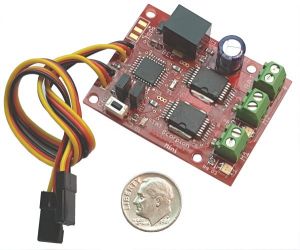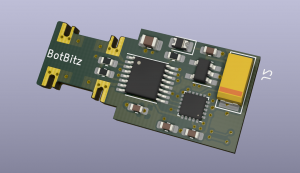Difference between revisions of "ESCs"
m (Link to motor article) |
(Editing and more considerations) |
||
| Line 9: | Line 9: | ||
*'''Brushed ESCs''' only drive brushed DC motors. | *'''Brushed ESCs''' only drive brushed DC motors. | ||
*'''Brushless ESCs''' only drive brushless motors. | *'''Brushless ESCs''' only drive brushless motors. | ||
| − | *'''Hybrid controllers''' | + | *'''Hybrid controllers''', like some from [https://home.castlecreations.com/ Castle Creations], can be set to either brushed or brushless mode. |
<br> | <br> | ||
=Selecting an ESC= | =Selecting an ESC= | ||
| Line 17: | Line 17: | ||
Considerations in selecting a suitable ESC include: | Considerations in selecting a suitable ESC include: | ||
| + | *'''Output type''' - Suitable for brushed (or brushless) [[Motors]] if used with a brushed (or brushless) motor. | ||
| + | *'''Safety''' - An ESC must stop running the motor if it stops receiving commands; otherwise, this could result in a runaway bot, or a bot that can't stop its weapon or prevent self-damage. | ||
*'''Battery Voltage''' - ESCs are rated for a maximum voltage. Exceeding this voltage may lead to immediate failure of the ESC. | *'''Battery Voltage''' - ESCs are rated for a maximum voltage. Exceeding this voltage may lead to immediate failure of the ESC. | ||
| − | *'''Continuous Current''' - An ESC should be able to provide the anticipated current requirement of the motor it controls for the full length of a match. An ESC that cannot provide the required current for the required time will stop working or burn out from thermal overload. Note that | + | *'''Continuous Current''' - An ESC should be able to provide the anticipated current requirement of the motor it controls for the full length of a match. An ESC that cannot provide the required current for the required time will stop working or burn out from thermal overload. Note that cheap ESCs often advertise high current ratings that they can't output for more than a few seconds. |
| − | *'''Peak Current''' - If brought to a stop | + | *'''Peak Current''' - If a motor is brought to a stop ("stalled"), it can demand a much more current than normal. Motors should be geared or clutched to avoid stalling, but combat damage can increase loading. Estimate the peak current your motor may require and select an ESC that will not be damaged by that current level. Try to be aware of your motors while driving, and shut off the power if a motor is jammed to preserve the ESC and wiring. Again, be wary of current ratings given for inexpensive hobby ESCs. |
*'''Size / Weight''' - Physical size and weight of a component is always a consideration when choosing components for combat robots.. This is especially true in small insect-class robots where every gram counts. | *'''Size / Weight''' - Physical size and weight of a component is always a consideration when choosing components for combat robots.. This is especially true in small insect-class robots where every gram counts. | ||
| + | *'''Sensor Capabilities''' - Advanced builders may want to use [[motors]] with shaft sensors and matching ESCs to better control speed, acceleration, or torque, making the bot easier to operate with precision. These units are more costly and usually require programming to achieve the desired performance. | ||
*'''Additional Features''' | *'''Additional Features''' | ||
**[[Battery_eliminator_circuit_(BEC)|Battery Elimination Circuit (BEC)]] - this takes the voltage from the battery down to a lower level that is more typically used in receivers and servos which eliminates the need for a second receiver battery. BECs on speed controllers typically don't provide a lot of current so if you are driving a servo you should consider a stand alone BEC. | **[[Battery_eliminator_circuit_(BEC)|Battery Elimination Circuit (BEC)]] - this takes the voltage from the battery down to a lower level that is more typically used in receivers and servos which eliminates the need for a second receiver battery. BECs on speed controllers typically don't provide a lot of current so if you are driving a servo you should consider a stand alone BEC. | ||
| Line 32: | Line 35: | ||
'''Warning: Advanced Topic'''. Beginners can ignore this section. | '''Warning: Advanced Topic'''. Beginners can ignore this section. | ||
| − | We've reached a time in history (and in hobbies) where it seems like every small device is run most cheaply by a tiny computer chip | + | We've reached a time in history (and in hobbies) where it seems like every small device is run most cheaply by a tiny computer chip, including ESCs. They operate according to built-in programming, or firmware. Reflashing the firmware changes how the ESC works, and therefore how the motor is driven and powered. |
'''BLHeli'''[https://github.com/bitdump/BLHeli] is a free and popular replacement firmware package. It's used along with a program on your computer called '''BLHeliSuite''' to reprogram brushless ESCs and adjust exactly how the motor is controlled. One common reason to do this is to take brushless ESCs made for other purposes, and make them fit for robot combat. | '''BLHeli'''[https://github.com/bitdump/BLHeli] is a free and popular replacement firmware package. It's used along with a program on your computer called '''BLHeliSuite''' to reprogram brushless ESCs and adjust exactly how the motor is controlled. One common reason to do this is to take brushless ESCs made for other purposes, and make them fit for robot combat. | ||
Revision as of 02:53, 25 March 2022
Electronic Speed Controllers, or ESCs, are circuits that let you control motor speed and direction remotely, using a signal from the radio receiver. One circuit board may have one or more motor controllers, and some small ESCs are integrated with a receiver to minimize size and weight for small bots. They are called "Electronic" speed controllers to distinguish from an obsolete electro-mechanical type which were used in RC models long ago (1980s?).
How ESCs work
An ESC plugs into the receiver. It changes the pulses that would have moved a servo, and makes them into a variable motor voltage instead. ESCs have a connection to draw power from the battery, and another to attach to the motor(s).
There are two completely different types.
- Brushed ESCs only drive brushed DC motors.
- Brushless ESCs only drive brushless motors.
- Hybrid controllers, like some from Castle Creations, can be set to either brushed or brushless mode.
Selecting an ESC
Note: Beginners may be quickly overwhelmed at the selection of ESCs available. It is convenient to choose ESCs that are specifically sold for use in combat robotics. A wide range of other ESCs are available for model hobby purposes, but you must select carefully. When in doubt, ask other builders.
Considerations in selecting a suitable ESC include:
- Output type - Suitable for brushed (or brushless) Motors if used with a brushed (or brushless) motor.
- Safety - An ESC must stop running the motor if it stops receiving commands; otherwise, this could result in a runaway bot, or a bot that can't stop its weapon or prevent self-damage.
- Battery Voltage - ESCs are rated for a maximum voltage. Exceeding this voltage may lead to immediate failure of the ESC.
- Continuous Current - An ESC should be able to provide the anticipated current requirement of the motor it controls for the full length of a match. An ESC that cannot provide the required current for the required time will stop working or burn out from thermal overload. Note that cheap ESCs often advertise high current ratings that they can't output for more than a few seconds.
- Peak Current - If a motor is brought to a stop ("stalled"), it can demand a much more current than normal. Motors should be geared or clutched to avoid stalling, but combat damage can increase loading. Estimate the peak current your motor may require and select an ESC that will not be damaged by that current level. Try to be aware of your motors while driving, and shut off the power if a motor is jammed to preserve the ESC and wiring. Again, be wary of current ratings given for inexpensive hobby ESCs.
- Size / Weight - Physical size and weight of a component is always a consideration when choosing components for combat robots.. This is especially true in small insect-class robots where every gram counts.
- Sensor Capabilities - Advanced builders may want to use motors with shaft sensors and matching ESCs to better control speed, acceleration, or torque, making the bot easier to operate with precision. These units are more costly and usually require programming to achieve the desired performance.
- Additional Features
- Battery Elimination Circuit (BEC) - this takes the voltage from the battery down to a lower level that is more typically used in receivers and servos which eliminates the need for a second receiver battery. BECs on speed controllers typically don't provide a lot of current so if you are driving a servo you should consider a stand alone BEC.
- Channel Mixing - Lets you operate multiple drive motors with just one control stick, even with the simplest radio transmitters. Applicable only to dual-channel ESCs that can control two motors.
- Reversible - If you are using the ESC to operate any motor that has to spin both ways (drive wheels, for example), the ESC must be "reversible" — that is, capable of bidirectional operation.
- Battery Monitoring and Protection - Shuts off the motor to save the battery from damage due to excessive discharge. Consider if you want your ESC to cut off power to your motor and leave you vulnerable late in a match -- it may be worth risking battery damage to keep fighting!
- Tuning Settings - May help you better control the bot or make the most out of your motors. Potentially useful for brushless ESCs.
- The ability to reflash (reprogram) the ESC; see below.
Reflashing ESCs
Warning: Advanced Topic. Beginners can ignore this section.
We've reached a time in history (and in hobbies) where it seems like every small device is run most cheaply by a tiny computer chip, including ESCs. They operate according to built-in programming, or firmware. Reflashing the firmware changes how the ESC works, and therefore how the motor is driven and powered.
BLHeli[1] is a free and popular replacement firmware package. It's used along with a program on your computer called BLHeliSuite to reprogram brushless ESCs and adjust exactly how the motor is controlled. One common reason to do this is to take brushless ESCs made for other purposes, and make them fit for robot combat.
It may be possible to reflash the firmware on an ESC meant for other uses to make it reversible. Here are some examples of ESCs that could be repurposed for robot combat.
- ESCs for car and truck applications have reversing ability, unless they have the very simplest of radio controls.
- ESCs designed for airplane flight are often intended to spin a propeller one way only. To save weight, airplane ESCs may also have smaller, lighter heat sinks intended for air cooled operation.
- ESCs made for quadcopter/drone applications are normally brushless and non-reversible, but can often be modified by reflashing.
- ESCs for boat duty may not be able to reverse, and some are designed to be water cooled and have no heat sink at all.

